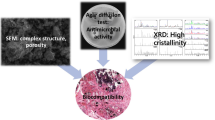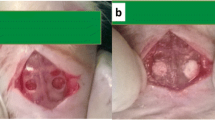Abstract
Several types of biodegradable materials have been investigated for the treatment of osteomyelitis. Calcium phosphate (CaP) ceramics are among the most performing materials due to their resemblance to human hard tissues in terms of mineralogical composition, and proven ability to adsorb and deliver a number of drugs. This research work was intended to study the suitability of modified CaP powders loaded with a fluoroquinolone as drug delivery systems for osteomyelitis treatment. Levofloxacin (LEV) was chosen due to the well-recognized anti-staphylococcal activity and adequate penetration into osteoarticular tissues. Substituted CaP powders (5 mol% Sr2+ or 5 mol% Mg2+) were synthesised through aqueous precipitation. The obtained powders were characterised by X-ray diffraction, SEM and FTIR analysis. The X-ray diffraction patterns confirmed the presence of HA and β-tricalcium phosphates (β-TCP) phases in doped compositions, especially in the case of Mg-doped system. The fixation of LEV at the surface of the particles occurred only by physisorption. Both the in vitro microbiological susceptibility, against Staphylococcus spp, and biocompatibility of LEV-loaded CaP powders have not been compromised.








Similar content being viewed by others
References
Lew DP, Waldvogel FA. Osteomyelitis. Lancet. 2004;364:79–369.
Lima ALL, Oliveira PR, Carvalho VC, et al. Recommendations for the treatment of osteomyelitis. Braz J Infect Dis. 2014;18(5):526–34.
Mader JT, Stevens CM, Stevens JH, et al. Treatment of experimental osteomyelitis with a fibrin sealant antibiotic implant. Clin Orthop Relat Res. 2002;403:58–72.
Soundrapandian C, Datta S, Sa B. Drug-eluting implants for osteomyelitis. Crit Rev Ther Drug Carrier Syst. 2007;24(6):493–545.
Soundrapandian C, Sa B, Datta S. Organic-inorganic composites for bone drug delivery. AAPS PharmSciTech. 2009;10(4):1158–71.
Chen L, Wang H, Wang J, et al. Ofloxacin-delivery system of a polyanhydride and polylactide blend used in the treatment of bone infection. J Biomed Mater Res B. 2007;83(2):589–95.
Gitelis S, Brebach GT. The treatment of chronic osteomyelitis with a biodegradable antibiotic-impregnated implant. J Orthop Surg. 2002;10:53–60.
Samit KN, Prasenjit M, Subhasis R, et al. Local antibiotic delivery systems for the treatment of osteomyelitis—a review. Mater Sci Eng C. 2009;29:2478–85.
Azi ML, Junior MK, Martinez R, et al. Bone cement and gentamicin in the treatment of bone infection: background and in vitro study. Acta Ortop Bras. 2010;18(1):31–4.
Klemm KW. Antibiotic bead chains. Clin Orthop. 1993;295:63–76.
Wei G, Kotoura Y, Oka M. Bioabsorbable delivery system for antibiotic treatment of osteomyelitis. J Bone Joint Surg. 1991;73(B):246–52.
Koort JK, Mäkinen TJ, Suokas E, et al. Efficacy of ciprofloxacin-releasing bioabsorbable osteoconductive bone defect filler for treatment of experimental osteomyelitis due to Staphylococcus aureus. Antimicrob Agents Chemother. 2005;49:1502–8.
Kanellakopoulou K, Giamarellos-Bourboulis EJ. Carrier systems for the local delivery of antibiotics in bone infections. Drugs. 2000;59(6):1223–32.
El-Ghannam A, Jahed K, Omran M. Nanoporous delivery system to treat osteomyelitis and regenerate bone: gentamicin release kinetics and bactericidal effect. J Biomed Mater Res B. 2005;73:277–84.
El-Ghannam A, Jahed K, Govindaswami M. Resorbable bioactive ceramicfor treatment of bone infection. J Biomed Mater Res A. 2010;94:308–16.
Uskokovic´ V, Desai TA. Phase composition control of calcium phosphatenanoparticles for tunable drug delivery kinetics and treatment of osteomyelitis. I. Preparation and drug release. J Biomed Mater Res A. 2013;101:1416–26.
Kim HW, Knowles JC, Kim HE. Hydroxyapatite/poly(epsilon-caprolactone) composite coatings on hydroxyapatite porous bone scaffold for drug delivery. Biomaterials. 2004;25(7–8):1279–87.
Ghosh SK, Nandi SK, Kundu B, et al. In vivo response of porous hydroxyapatite and beta-tricalcium phosphate prepared by aqueous solution combustion method and comparison with bioglass scaffolds. J Biomed Mater Res B. 2008;86(1):217–27.
de Lima IR, Alves GG, Soriano CA, et al. Understanding the impact of divalent cation substitution on hydroxyapatite: an in vitro multiparametric study on biocompatibility. J Biomed Mater Res A. 2011;98(A):351–8.
Ergun C, Webster TJ, Bizios R, et al. Hydroxylapatite with substituted magnesium, zinc, cadmium, and yttrium. I. Structure and microstructure. J Biomed Mater Res. 2002;59:305–11.
Boanini E, Gazzano M, Bigi A. Ionic substitutions in calcium phosphates synthesized at low temperature. Acta Biomater. 2010;6:1882–94.
Kannan S, Lemos AF, Ferreira JMF. Synthesis and mechanical performance of biological-like hydroxyapatites. Chem Mater. 2006;18(8):2181–6.
Pina S, Vieira SI, Rego P, et al. Biological responses of brushite-forming Zn- and ZnSr-substituted β-tricalcium phosphate bone cements. Eur Cells Materials. 2010;20:162–77.
LeGeros RZ. Calcium phosphates in oral biology and medicine. Monogr Oral Sci. 1991;15:1–201.
Ren F, Leng Y, Xin R, et al. Synthesis, characterization and ab initio simulation of magnesium-substituted hydroxyapatite. Acta Biomater. 2010;6:2787–96.
Gibson IR, Bonfield W. Preparation and characterization of magnesium/carbonate co-substituted hydroxyapatites. J Mater Sci. 2002;13:685–93.
Rimmelé T, Boselli E, Breilh D, et al. Diffusion of levofloxacin into bone and synovial tissues. J Antimicrob Chemother. 2004;53:533–5.
Holtom PD, Pavkovic SA, Bravos PD, et al. Inhibitory effects of the quinolone antibiotics trovafloxacin, ciprofloxacin, and levofloxacin on osteoblastic cells in vitro. J Orthop Res. 2000;18(5):721–7.
Arcos D, Rodriguez Carvajal J, Vallet Regi M. The effect of the silicon incorporation on the hydroxyapatite structure. A neutron diffraction study. Solid State Sci. 2004;6:987–94.
Nicolopoulos S, Gonzalez Calbet JM, Alonso MP, Gutierrez Rios MT, De Frutos MI, Vallet Regi M. Characterization by TEM of local crystalline changes during irradiation damage of hydroxyapatite compounds. J. Solid State Chem. 1995;116:265–74.
Hart E, Azzopardi K, Taing H, et al. Efficacy of antimicrobial polymer coatings in an animal model of bacterial infection associated with foreign body implants. J Antimicrob Chemother. 2010;65:974–80.
Clinical and Laboratory Standards Institute (CLSI). Methods for dilution antimicrobial susceptibility tests for bacteria that grow aerobically, approved standard. 9th ed. CLSI: Wayne; 2012.
Clinical and Laboratory Standards Institute (CLSI). Performance Standards for Antimicrobial. 560 Susceptibility Testing, Seventeenth Informational Supplement, M100–S17. CLSI: Wayne; 2007.
Cadete A, Figueiredo L, Lopes R, et al. Development and characterization of a new plasmid delivery system based on chitosan-sodium deoxycholate nanoparticles. Eur J Pharm Sci. 2012;45:451–8.
Lopes R, Eleutério CV, Gonçalves LMD, et al. Lipid nanoparticles containing oryzalin for the treatment of leishmaniasis. Eur J Pharm Sci. 2012;45:442–50.
Matos A, Gonçalves LM, Rijo P, et al. A novel modified acrylic bone cement matrix. a step forward on antibiotic deliver against multiresistant bacteria responsible for prosthetic joint infections. Mater Sci Eng C. 2014;38:218–26.
Torres PMC, Abrantes JCC, Kaushal A, Pina S, Döbelin N, Bohner M, Ferreira JMF. Influence of Mg-doping, calcium pyrophosphate impurities and cooling rate on the allotropic α↔ β-tricalcium phosphate phase transformations. J Eur Ceram Soc. 2016;36(3):817–27.
Koutsopoulos S. Synthesis and characterization of hydroxyapatite crystals: a review study on the analytical methods. J Biomed Mater Res. 2002;62(4):600–12.
Shahwal VK, Dubey BK, Bhoumick M. Preformulation study of Levofloxacin. Int J Adv Pharm. 2012;1:1–8.
Gevariya HB, Gami S, Patel N. Formulation and characterization of levofloxacin-loaded biodegradable nanoparticles. Asian J Pharm. 2011;5:114–9.
Kannan S, Lemos IAF, Rocha JHG, et al. Synthesis and characterization of magnesium substituted biphasic mixtures of controlled hydroxyapatite/β-tricalcium phosphate ratio. J Solid State Chem. 2005;178:3190–6.
Kannan S, Ventura JM, Ferreira JMF. Aqueous precipitation method for the formation of Mg-stabilized β-tricalcium phosphate: an X-ray diffraction study. Ceram Int. 2007;33(4):637–41.
Kannan S, Goetz-Neunhoeffer F, Neubauer J, et al. Rietveld structure and in vitro analysis on the influence of magnesium in biphasic (hydroxyapatite and β-tricalcium phosphate) mixtures. J Biomed Mater Res Part B. 2009;90B(1):404–11.
Kannan S, Pina S, Ferreira JMF. Formation of strontium-stabilized β-tricalcium phosphate from calcium-deficient apatite. J Am Ceram Soc. 2006;89(10):3277–80.
Kannan S, Goetz-Neunhoeffer F, Neubauer J, et al. Synthesis and structural characterization of strontium- and magnesium-co-substituted beta-tricalcium phosphate. Acta Biomater. 2010;6(2):571–6.
Gibson IR, Rehman I, Best SM, et al. Characterization of the Transformation from Calcium-Deficient Apatite to β-Tricalcium Phosphate. J Mater Sci Mater Med. 2000;11(12):799–804.
Kim T-W, Park YM, Kim D-H, et al. In situ formation of biphasic calcium phosphates and their biological performance in vivo. Ceram Int. 2012;38(3):1965–74.
Queiroz AC, Santos JD, Monteiro FJ, et al. Adsorption and release studies of sodium ampicillin from hydroxyapatite and glass-reinforced hydroxyapatite composites. Biomaterials. 2001;22:1393–400.
Palazzo B, Iafisco M, Laforgia M, et al. Biomimetic hydroxyapatite-drug nanocrystals as potential bone substitutes with antitumor drug delivery properties. Adv Funct Mater. 2007;17:2180–8.
Hasegawa M, Sudo A, Komlev VS, et al. High release of antibiotic from a novel hydroxyapatite with bimodal pore size distribution. J Biomed Mater Res Part B. 2004;70:332–9.
Seshima H, Yoshinari M, Takemoto S, et al. Control of bisphosphonate release using hydroxyapatite granules. J Biomed Mater Res Part B. 2006;78:215–21.
Shinto Y, Uchida A, Korkusuz F, et al. Calcium hydroxyapatite ceramic used as a delivery system for antibiotics. J Bone Joint Surg B. 1992;74:600–4.
Sasikumar S. Effect of particle size of calcium phosphate based bioceramic drug deliver y carrier on the release kinetics of ciprofloxacin hydrochloride: an in vitro study. Front Mater Sci. 2013;7(3):261–8.
Ferreira JMF, Olhero SM, Kaushal A. Is the ubiquitous presence of barium carbonate responsible for the poor aqueous processing ability of barium titanate? J Eur Ceram Soc. 2013;33:2509–17.
Olhero SM, Kaushal A, Ferreira JMF. Fabrication of barium strontium titanate (Ba0.6Sr0.4TiO3) 3D microcomponents from aqueous suspensions. J Am Ceram Soc. 2014;97(3):725–32.
Kaushal A, Olhero SM, Sing B, et al. Impedance analysis of 0.5Ba(Zr0.2Ti0.8)O3–0.5(Ba0.7Ca0.3)TiO3 ceramics consolidated from micro-granules. Ceram Inter. 2014;40(7):10593–600.
Matos AC, Marques CF, Pinto RV, Ribeiro IAC, Gonçalves LM, Vaz MA, Ferreira JMF, Almeida AJ, Bettencourt AF. Novel doped calcium phosphate-PMMA bone cement composites as levofloxacin delivery systems. Int J Pharm. 2015;490:200–8.
Wu P, Grainger DW. Drug/device combinations for local drug therapies and infection prophylaxis. Biomaterials. 2006;27:2450–67.
ISO. International Standard ISO Specification 10993(5): Biological evaluation of medical devices—Part 5: Tests for in vitro cytotoxicity. 3rd ed. Geneva: ISO; 2009.
Acknowledgments
The authors thank CICECO and CBC PEst-OE/SAU/UI0482/2014, Research Units of the University of Aveiro, iMed.ULisboa, Research Unit of Faculty of Pharmacy, University of Lisbon (strategic project PEst-OE/SAU/UI4013/2014) for financial support, and also FCT for the fellowship Grant to Catarina Marques (SFRH/BD/78355/2011).
Author information
Authors and Affiliations
Corresponding author
Rights and permissions
About this article
Cite this article
Marques, C.F., Matos, A.C., Ribeiro, I.A.C. et al. Insights on the properties of levofloxacin-adsorbed Sr- and Mg-doped calcium phosphate powders. J Mater Sci: Mater Med 27, 123 (2016). https://doi.org/10.1007/s10856-016-5733-2
Received:
Accepted:
Published:
DOI: https://doi.org/10.1007/s10856-016-5733-2




